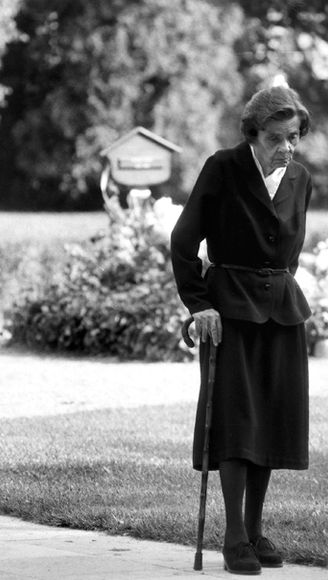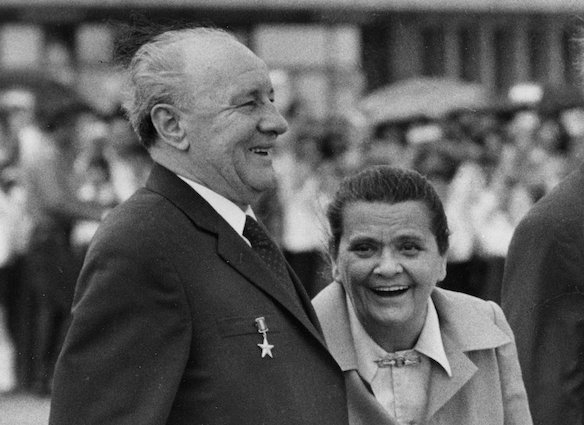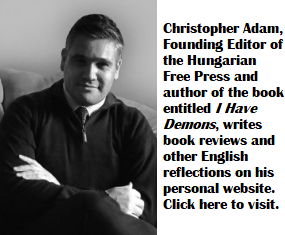A Hungarian quarterly history magazine entitled Múlt-kor published essays in its spring 2016 print issue on the spouses of seven prominent twentieth century dictators. The magazine is not a strictly academic publication as such, but is rather an effort by researchers to present aspects of Hungarian and world history to a somewhat broader reading audience than one that would be inclined to read academic journals. György Majtényi, a department head at the National Archives of Hungary, wrote an essay on Mária Tamáska (1912-1992), the wife of Hungary’s communist ruler János Kádár, and on the more personal aspects of the couple’s life. János Kádár was an iconic ruler in Eastern Europe, from 1956 to 1989. While his rule began with the persecution of those who had participated in the suppressed 1956 Hungarian Revolution, starting in 1968, he became known for what is often termed “Goulash Communism”–a socialist one party state, which allowed for limited forms of private ownership, aimed to instill loyalty to the regime by offering a generally higher living standard for most citizens than almost anywhere else in the Eastern Bloc, better access to a variety of consumer goods and more tolerance towards alternative forms of cultural expression and even limited, but non-threatening critiques of the regime and the ruling Hungarian Socialist Workers’ Party (MSZP).
Mr. Majtényi’s essay focuses less on Mr. Kádár’s politics, and much more on his personal life, and that of his wife. The picture presented in this piece questions the dominant narrative in some quarters, namely that the Kádárs lived a simple, almost ascetic existence, in keeping with Marxist values. That having been said, what the essay describes about Mr. and Mrs. Kádár’s lifestyle suggests that they lived comfortably, but certainly not extravagantly. They certainly did not enjoy–and probably had little desire for–the sort of opulence and extreme indulgence of Nicolae and Elena Ceaușescu.
The Kádárs, married in 1949, lived a very private and probably lonely life in a spacious, 173 square meter villa, in the leafy Rózsadomb neighbourhood of Buda. Married relatively late in life (Mrs. Kádár was 37 and her husband was a few months younger), the couple had no children. Mr. Kádár, who was imprisoned by the Stalinist regime between 1951 and 1954, claimed that torture and repeated beatings by his captors left him infertile. Mr. Majtényi, however, did not find any mention of infertility in archived medical records. The author suspects that since both Mr. and Mrs. Kádár were 42 years old once he was released from prison, this may be a more likely explanation for why they remained childless.
Both Mária Tamáska and János Kádár came from humble origins, but their intellectual interests–based on what they left behind in their house after their death–were diverse and they were well-read. The Kádárs had a private library comprised of some 4,200 books, several of which were in foreign languages. Based on notes that were found after their death, Mrs. Kádár was learning German and she likely had some basic reading knowledge of French as well. Near the end of her life, Mrs. Kádár had a catalog produced of the English-language books in her collection. Her interest in the written word–including foreign languages–makes sense, considering that she once worked as a censor, opening and examining private mail.
The Kádárs also had an affinity for art. In 1989, Mrs. Kádár recounted how she would buy a painting most years, on the occasion of her husband’s birthday, and usually through various auctions. By the late eighties, the Kádárs owned original works of art from some of Hungary’s most preeminent artists (Huber Dési, Gyula Derkovits, Béla Czóbel and József Rippl-Rónai), as well as a numbered print by Pablo Picasso. Mrs. Kádár was also astounded by both Rome and the Vatican, following a visit in 1977. She spoke about how she and her husband were allowed up close to the Pietà, in St. Peter’s Basilica, where she mentioned that the two of them “marvelled” Michelangelo’s statue of Mary holding the body of the crucified Jesus. In an interview, Mrs. Kádár spoke of Rome as an “unparalleled museum, full of remarkable works of art.”
“Their house contained almost nothing that would have reflected the ideology of the regime,” noted Mr. Majtényi of Mr. and Mrs. Kádár’s home. The historian added that most of the villa was furnished in a Neo-Baroque style. The author appears to emphasize in his piece just how much higher the quality of life enjoyed by the Kádár’s was from that of most Hungarians. Mrs. Kádár, for example, was a high-ranking civil servant until her retirement in 1980. If compared to today’s positions, her role was similar to that of an assistant deputy minister, with her work focusing on the monitoring of the émigré press. Given her relatively high-ranking position in the bureaucracy, Mrs. Kádár’s salary in the late fifties was approximately one third of what a government minister would earn. By 1974, however, Mrs. Kádár earned the salary of a deputy minister and her income was approximately half of her husband’s wage. From reading Mr. Majtényi’s piece, and based on what I have read from other sources, Mr. and Mrs. Kádár lived affluently–as would most heads of government and heads of state–but their lifestyle was not one that I would describe as luxurious.
By the end of the eighties, the loneliness that enveloped the Kádárs through much of their life deepened significantly. Mr. Kádár’s health was deteriorating and he was removed from his position as Secretary General in 1988, remaining instead the largely ceremonial chair of the Hungarian Socialist Workers’ Party (MSZMP). On April 12th, 1989, the largely sidelined Mr. Kádár gave a rambling, partially incoherent hour-long speech in a meeting of the Central Committee. The iconic leader’s deteriorated mental state shocked those present. Some have suggested that it may have been in the interest of Mr. Kádár’s successor, Károly Grósz, to have the MSZMP officials see the former secretary general in this state, in order to hasten his removal. And removed he was, from his last remaining positions, in May 1989, just weeks before he died.
When Mr. and Mrs. Kádár left party headquarters for the final time in April 1989, the elderly couple departed the building together, without any security guards and without anyone to walk them to the door. György Aczél, Hungary’s former Minister of Culture, described the scene by noting: “two lonely old people head down the stairs. The seriously ill woman holds her husband, guiding the old man.”

Mrs. Kádár in 1989. She lived a lonely, isolated life following the death of her husband and the demise of his regime.
János Kádár died on June 6, 1989 and Mrs. Kádár lived the remaining two years of her life in almost complete isolation, and seemingly oblivious to the change in regime and transition to multi-party democracy. She established the János Kádár Foundation (Kádár János Alapítvány), in order to keep her husband’s legacy alive. In her remaining two years, she lived on a modest state pension (28,000 forints, or then approximately $300) , but seemed to save almost all of it, in order to invest more funds in the foundation. She still employed a cleaning lady, who helped with shopping for basic essentials. But remaining handwritten notes suggest that Mrs. Kádár lived on almost nothing. For instance, between February 18th and March 4th 1992, she spent a total of 2,000 forints (which at he time would have been the equivalent of less than $25) on newspapers, toothpaste, toilet paper, stockings and wine. Every expenditure–down to the most basic item–was noted.
Mrs. Kádár would hold receptions in her home on the occasion of her late husband’s birthday, and would hand out awards and prizes amongst the participants. She died on March 30th, 1992 and left her estate to the newly formed foundation, which remained in operation until 2007, when it finally folded.
Note:
The complete Hungarian-language text of György Majtényi’s essay, entitled “Mária Tamáska, in the shadow of the ‘old man,'” is available only in print in the Spring 2016 issue of Múlt-kor, pgs.. 68-77.




